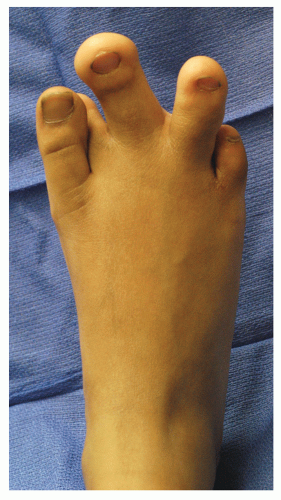Macrodactyly
Thomas A. Brosky II
ETIOLOGY
Macrodactyly is a rare and uncertain congenital deformity of the hands and feet. The condition may occur unilaterally or bilaterally, and syndactyly can be an occasional finding (1). Typically, the condition presents unilaterally and demonstrates a slight male predominance. Involvement of the fourth and fifth digits is rare. True macrodactyly can involve enlargement of phalanges, tendons, nerves, vessels, subcutaneous fat, nails, and skin (Fig. 75.6).
In 1967, Barsky (1) described two general forms of true macrodactyly. The “static type” is present at birth and enlarges proportionally with growth. Hypertrophy does not extend proximally to the digit. The second type is termed “progressive” since there is disproportionate growth of the affected digit. The deformity usually involves proximal tissue and progresses so rapidly that the patient presents at an early age with grotesque deformity. Rarely is there a family history of macrodactyly, which suggests that heredity does not play a part in this deformity (2).
TREATMENT
There is no gold standard treatment for this deformity. The management is based on the location and age of the deformity itself. Severe hypertrophy can cause psychological ramifications as well as physical complications in ambulation. The main goal of surgery is to obtain a pain-free plantigrade foot with a shoe size similar to the contralateral normal foot. Since this is a complex deformity affecting bone and soft tissue structures, staging the procedure may be best to achieve these goals. Standard radiographs are the mainstay in surgical preparation. Length measurements and secondary deformities can be easily assessed. Magnetic resonance imaging and computerized tomography scans have also been used to help in surgical planning (3,4).
Stay updated, free articles. Join our Telegram channel

Full access? Get Clinical Tree









